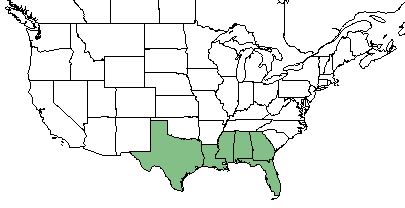Difference between revisions of "Agalinis pulchella"
| Line 30: | Line 30: | ||
==Ecology== | ==Ecology== | ||
===Habitat=== <!--Natural communities, human disturbed habitats, topography, hydrology, soils, light, fire regime requirements for removal of competition, etc.--> | ===Habitat=== <!--Natural communities, human disturbed habitats, topography, hydrology, soils, light, fire regime requirements for removal of competition, etc.--> | ||
| − | ''A. pulchella'' is found in pine savannas and sandhills of the southeastern United States.<ref name="Weakley 2015">Weakley AS (2015) Flora of the Southern and Mid-Atlantic States. Chapel Hill, NC: University of North Carolina Herbarium.</ref> | + | ''A. pulchella'' is found in pine savannas and sandhills of the southeastern United States.<ref name="Weakley 2015">Weakley AS (2015) Flora of the Southern and Mid-Atlantic States. Chapel Hill, NC: University of North Carolina Herbarium.</ref> Another paper describes ''A. pulchella'' being found in dry open sandy longleaf-pinelands on the southeastern coastal plain.<ref name="Pennell 1929"/> |
===Phenology=== <!--Timing off flowering, fruiting, seed dispersal, and environmental triggers. Cite PanFlora website if appropriate: http://www.gilnelson.com/PanFlora/ --> | ===Phenology=== <!--Timing off flowering, fruiting, seed dispersal, and environmental triggers. Cite PanFlora website if appropriate: http://www.gilnelson.com/PanFlora/ --> | ||
Revision as of 19:58, 26 January 2018
| Agalinis pulchella | |
|---|---|
| Scientific classification | |
| Kingdom: | Plantae |
| Division: | Magnoliophyta - Flowering plants |
| Class: | Magnoliopsida - Dicots |
| Order: | Scrophulariales |
| Family: | Scrophulariaceae |
| Genus: | Agalinis |
| Species: | A. pulchella |
| Binomial name | |
| Agalinis pulchella Pennell | |

| |
| Natural range of Agalinis pulchella from USDA NRCS Plants Database. | |
Common name: St. Mark's false foxglove[1]
Contents
Taxonomic Notes
Synonym: Gerardia pulcherrima[1][2]
Description
Agalinis pulchella is a dioecious annual that grows as a forb/herb.[1] It is dull green to purplish with stems 6-10 dm tall. Leaves are opposite, or sub-opposite, spreading, narrowly linear, acute, entire, with stems 2-3 cm long. Seeds are 0.5-0.7 mm long and broadly triangular to quadrangular.[3] Cotyledons were orbicular to orbicular-ovate and 0.8-1.3 mm wide and long.[4] Seeds have a striate-tuberculate radial wall.[5]
Distribution
This species is found from Texas, eastward to Florida and Georgia.[1]
Ecology
Habitat
A. pulchella is found in pine savannas and sandhills of the southeastern United States.[2] Another paper describes A. pulchella being found in dry open sandy longleaf-pinelands on the southeastern coastal plain.[3]
Phenology
In North America, this species flowers in September and fruits in October.[3]
Conservation and Management
Cultivation and restoration
Photo Gallery
References and notes
- ↑ 1.0 1.1 1.2 1.3 USDA NRCS (2016) The PLANTS Database (http://plants.usda.gov, 26 January 2018). National Plant Data Team, Greensboro, NC 27401-4901 USA.
- ↑ 2.0 2.1 Weakley AS (2015) Flora of the Southern and Mid-Atlantic States. Chapel Hill, NC: University of North Carolina Herbarium.
- ↑ 3.0 3.1 3.2 Pennell FW (1929) Agalinis and allies in North America: II. Proceedings of the Academy of Natural Sciences of Philadelphia 81:111-249.
- ↑ Canne JM (1983) The taxonomic significance of seedling morphology in Agalinis (Scrophulariaceae). Canadian Journal of Botany 61:1868-1874.
- ↑ Canne JM (1979) A light and scanning electron microscope study of seed morphology in Agalinis (Scrophulariaceae) and its taxonomic significance. Systematic Botany 4(4):281-296.